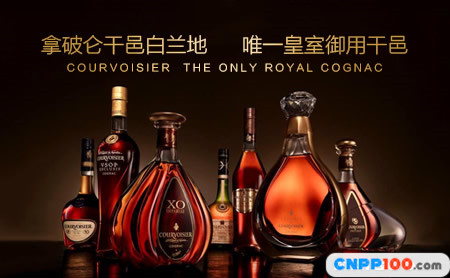
Courvoisier Napoleon, born in France in 1835, because its founder was very familiar with Napoleon, often sent fine wine to the court for drinking and feasting, so this wine is known as "Napoleon's wine", and was acquired by the Japanese Suntory company in 2014
At the beginning of the 19th century, Emmanuel. Emmanuel Courvoisier came to Paris and met Louis. Louis Gallois, a successful wine merchant. They did business in partnership and succeeded in obtaining a license to serve wine to the royal court. In 1811, Napoleon visited their winery in Bercy and asked them to supply him cognac. Later, when Napoleon was exiled to St. Helen, Courassier cognac was placed on the British ship "Northumberland", and from then on it was called Napoleonic brandy. Today the silhouette of Napoleon serves as the symbol of all Couasier cognacs.
In 1835, the founder's descendants merged the businesses and established their headquarters in Járnak.
In 1869, it was officially appointed supplier of wine to Napoleon III.
In 1909, the company was transferred to Guy and George. In the hands of Guyand George Simon (they are Englishmen of French ancestry). Marketing was reformed, including the use of frosted glass bottles in 1960. In 1964 Couasiye became the name of Hiram. Acquired by HiramWalker, sold to Allied-Lyons in 1987, and changed to Allied-Domecq in 1994. Domec bought). Today, the company has 300 employees. Couasier is today one of the leading cognac companies.
1.1 million bottles (13% of the market) are shipped annually to 160 countries and regions, especially in the United States, the United Kingdom, duty-free shops, Japan, Hong Kong, Italy and France. It is the number one supplier or peer in 46 markets.
It does not have its own vineyards, but it has a cycle contract with 1,200 vineyard owners to supply sprinkles, wines and some cognacs. This means that it has 24,700 hectares of vineyards under its contract, spread over the four major appellations (Grande and Petit Champs, Bordry and Finberga), with 98% of the grapes being Wuyi Blanc grapes.
Couasiye has two distilleries in Chatonave-sur-Charente, near Jardnak; It also signed contracts with nine winemakers and bought wine from 200 local winemakers. Courvasier harmonizes the colour with no more than 1% caramel in the VS and VSOP grades. No preheating is used in the distillation furnace room. Residue or slag removal depends on the year (e.g. 1966 was used to remove slag during distillation due to complications), but Finbeva does not care because of its short shelf life. It also does not use wood shavings to soak willows, because the natural color of some new wood makes the wine taste clearer.
The wood used for wine storage is sourced from the forests of central France to obtain a more detailed wood grain. The oak trees are selected by the conditioner himself and then dried for 3 years before being used. The new wine is kept in new barrels for 6-24 months, depending on the final wine grade. Then it was transferred to the old barrel for the rest of the brew. Every year it buys about 2,000 new barrels, mostly supplied by three coopers.
In the cellar of Járnak you can find four barrels stacked for 3 to 4 years. The cognac is aged at 70 degrees of saturation for 3 months and then reduced to 60 degrees. VS will be stored for another 1 year to reduce to 55 degrees, while others will be stored for 5 to 7 years. Sucrose syrup is added before being bottled.
All grades are marketed at 40 degrees. The company has maintained a high stock of 86 million bottles, in order to ensure a uniform style every year. Courassier has received several awards, including the title of Light of France in 1983, the title of World XO at the International Grand Wine Competition in 1986, and the Cyril Ray Trophy in 1994 for the XO Empire for the best cognac. Couasiye also has a Salignac plant, which is mainly used for the North American market.
In addition to the production of cognac, the company also has a factory that produces regional wines under the brand name VindePaysCharentais. It is bottled and shipped to the UK market, or exported to Germany in bulk for sparkling wine.
On the banks of the Charente, Couasière has a magnificent museum of Napoleon's life. Among them is the wardrobe is his famous hat, tunics, waistcoat, and even a strand of hair. Visitors can see the entire process from grape production to distillation, barrel making and conditioning of the various grades. The oldest bottles contain very old wines, such as the "upstairs" until 1789, while some glass jars also contain old wines.
The artistic design of Courassier's cognac was designed by Erte, a French organization of art-deco artists, and began in 1988. The first design, called "Vigne" (Grape), consisted of only 12,000 bottles – as were the case in the next six editions – including the 1892 Grande Champagne. Eltai has its artistic freedom in both the design of the bottle and the decoration. On these bottles, the golden leaves symbolize the noble grape quality that makes these rare blended wines.
Each bottle is processed independently for more than 1 month, including screen printing in 18 different colors and firing in 4 kilns. The bottle is plated with 24-karat gold by hand gilding. The motifs are grapes, harvest, distillation, winemaking, critique, the spirit of cognac, Amban'er and nude, the latter of which has only 4,000 bottles.












